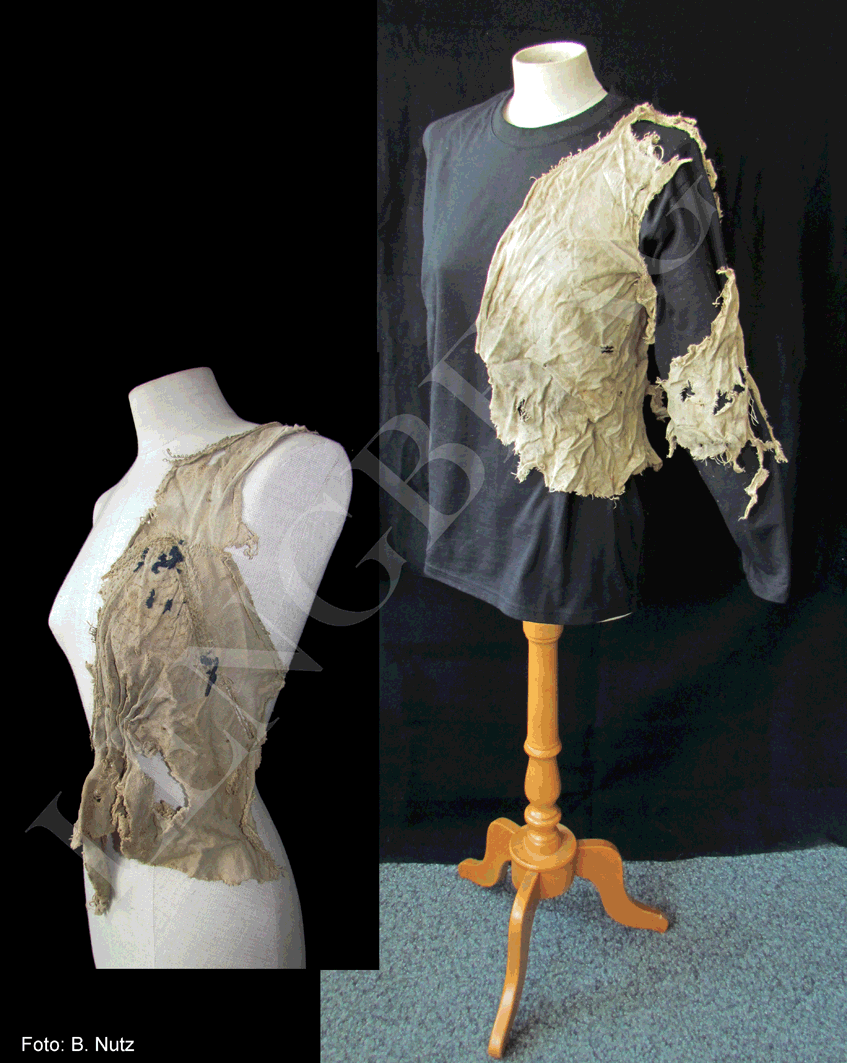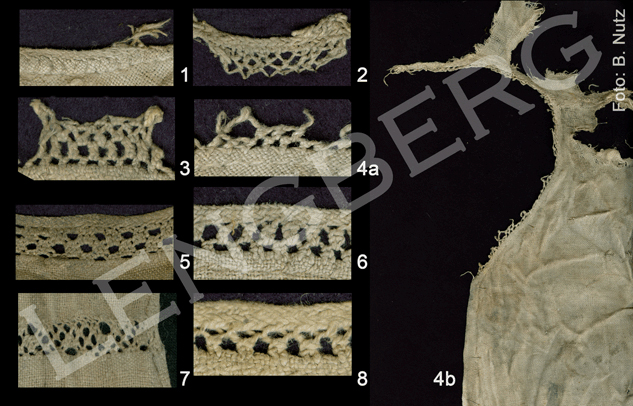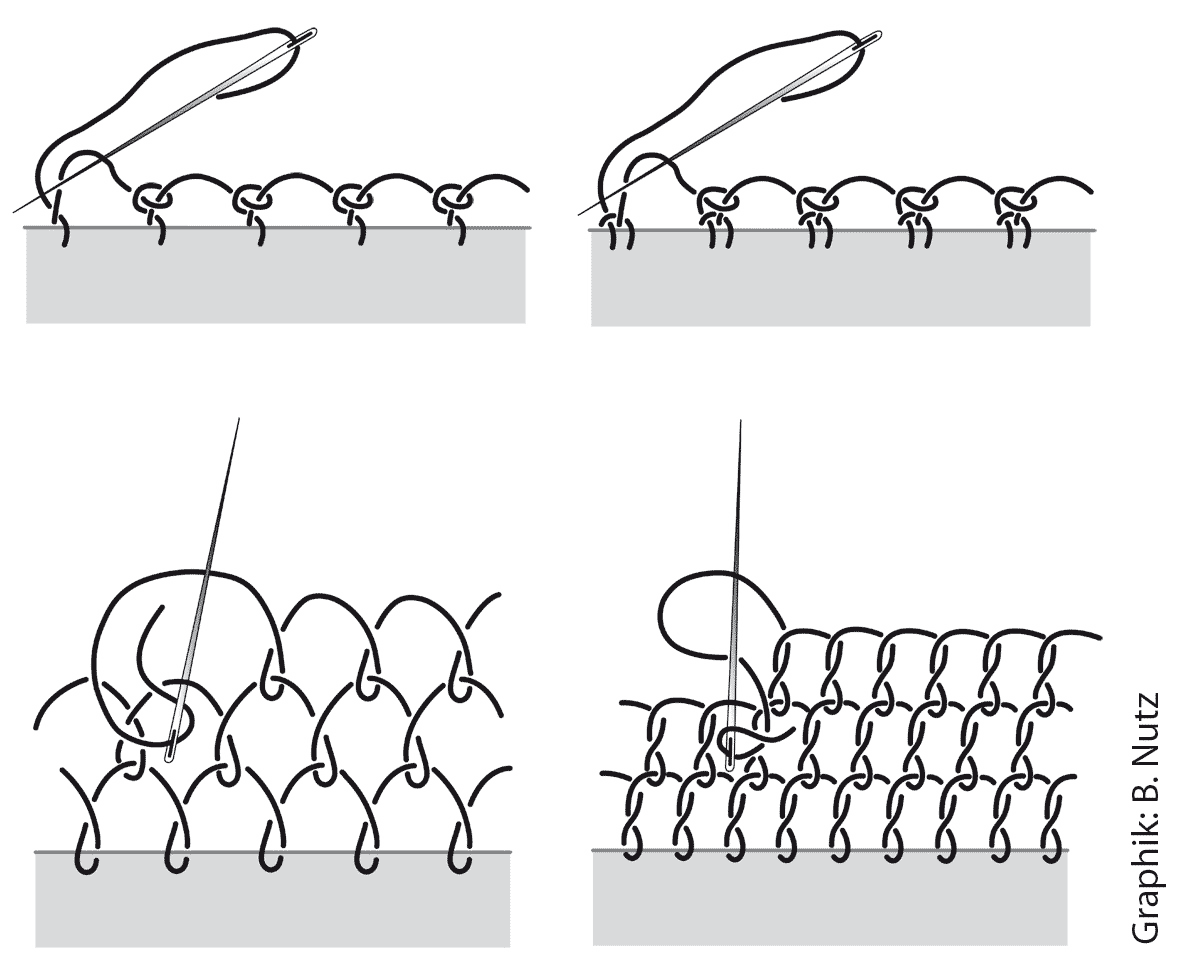Projects und Science
The “Invention” of Needle-lace in East Tyrol?
Researchproject ABT
funded by the Tyrolean Science Fund (TWF)
Among the 15th century textiles from Lengberg Castle, salvaged in 2008 during reconstruction, are fragments of various shirts (Fig. 1, bottom left and right) made of linen and linen lining (Fig. 1, top left) of former woolen clothes. Now, for the first time, the larger fragments can be displayed in their wearing method by using dress forms. The two dress forms were provided to the research project “Mittelalterliche Textilien von Schloss Lengberg, Osttirol” and the Arbeitsgruppe für Bekleidung und textile Techniken (ABT, Work Group for Apparel and textile Techniques), Institute of Archaeology, Department of Medieval and Modern Archaeology, University of Innsbruck, by the tailor´s-shop Maß-Moden-Mauracher, Jenbach.

Fig 1: Fragment of a linen lining of a formerly blue wool dress (left). - Linen shirt with partly preserved left sleeve (right).
Some of the fragments of linen clothes are additionally decorated at the seams with finger-loop braided laces (Fig. 2, 1). These laces were either sewn directly onto the edge of the hem or connected to the linen fabric with simple needle-lace, sewn with linen ply-yarn, in between (Fig. 2). In the case of the shirt fragment (Fig. 1, right) which has parts of the left sleeve preserved, the needle lace served as decoration on the neck décolletage. Unfortunately here the finger-loop-lace is missing (Fig. 2, 4a and 4b).

In contrast to Reticella lace, a cutwork in which threads are pulled from linen fabric to make a "grid" on which the pattern is stitched using buttonhole stich, the needle-lace from Lengberg requires no fabric ground but is sewn "in the air" using various lace-stitches1 (Fig . 3). Proof is provided as the needle-laces are attached to the seams and one lace has been worked between two selvages and not used for sewing on a finger-loop-lace (Fig. 2, 7). This may be the beginnings of a technique called "punto in aria" = "stitch in air" or "lace in air", which is said to be first mentioned by Giovanni Antonio Tagliente in 1527 (or 1528) in his pattern book Essempio di recammi2. Punto in aria is considered to be the first true lace (i.e., lace not worked on a woven fabric). The fabric ground is replaced by a heavy thread or braid tacked onto a temporary backing (e.g., parchment), the finished lace thus providing its own structure3. It cannot be determined if a temporary parchment backing to work the lace was also used in Lengberg, but here the patterns are fairly simple and can probably be worked without a pattern base. In addition there is no thread or braid used as a “grid” for the lace-stitches as in Punto in aria.

In her Encyclopedia of Needlework Thérèse de Dillmont describes what she calls Irish- or Renaissance lace: “Irish lace, also known under the name of Renaissance lace, from its having been first made in the sixteenth century, is an imitation of the earliest pillow laces; ...It is composed of braid or tape, formed into figures, joined together by needlemade, corded or buttonhole bars and fillings of different kinds, or by bars alone”4. In case of the needle-lace from Lengberg the tape or braid is replaced by the fabric and/or the finger-loop-lace. Thérèse de Dillmont also implies that pillow- or bobbin-lace came first and Irish lace is imitating it, but the needle-lace on the textiles from Lengberg Castle is older than any known bobbin-lace.
How old is the technique of needle-lace?
Up to today it seems to be commonly believed that true needle-lace came into existence somewhere in the early 16th century. Now the finds from Lengberg Castle - the dating of the finds to the 15th century being confirmed by 14C-dates - raise the question anew where and when the first needle-lace was actually created. The close proximity of East Tyrol to Italy suggests influences of the early Italian Renaissance, but it has to be taken into consideration that Antonio Tagliente probably copied some patterns from older German pattern books for his work. For example from the oldest dated book of Hans Schönsperger, Ein new Modelbuch (Zwickau 1524), and from Peter Quentel´s Eyn new kunstlich Boich (Cologne 1527). But even Hans Schönperger´s book was not the first. This is being indicated by the addition to the title where it says: Gemert vñ gepessert mitt new andern Modeln (Enhanced and improved with new other patterns). Needle-lace being "invented" in a German region in the 15th century is therefore not impossible - perhaps even in East-Tyrol?
1 Full titel: Opera nuoua che insegna alle donne a cusire, a racammare & a disegnar a ciascuno, et la ditta opera sara di molta utilita ad ogni artista, per esser il disegno ad ognuno necessario, la qual e intitolata esempio di recammi (Venice 1528). Mentioned in: JOURDAIN Margaret, Old lace – a handbook for collectors (London 1909) p. 14 (online at the Open Library – HERE).
LOTZ Arthur, Bibliographie der Modelbücher. 2nd ed. (Stuttgart 1963) plate 45.
2 The new Encyclopædia Britannica, Vol. 9, 15th ed. (Chicago 2005) 803.
3 DILLMONT Thérèse de, Encyclopedia of Needlework – online “Project Gutenberg” HERE (English version)
4 HARRINGTON DANIELS Margaret, Early pattern books for lace and embroidery. In: The Bulletin of the Needle and Bobbin Club 17/2, 1933, 6 and LOTZ Arthur, Bibliographie der Modelbücher. 2nd ed. (Stuttgart 1963) plate 3, 5.